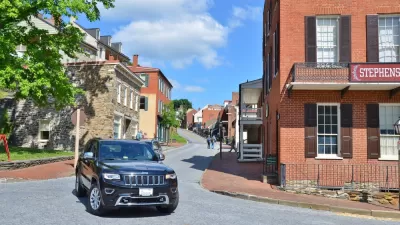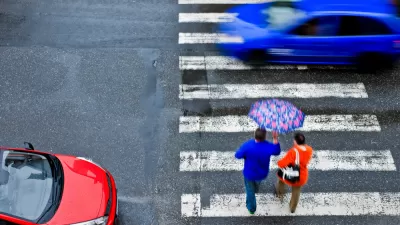While much focus is on the future of autonomous vehicles, the increase in pedestrian deaths related to SUVs remains a largely ignored issue.

Recent debates about self-driving vehicles and public safety have overshadowed the long-standing issue of SUVs, writes Henry Grabar. The overall number of traffic fatalities decreased in 2018, but pedestrian and cyclist deaths are on the rise. More SUVs are on the road, and that is part of the problem, says Grabar:
In February, the Governors Highway Safety Association estimated that more than 6,200 pedestrians died in 2018—the highest number in a generation, and an increase of 50 percent from 2009. The GHSA says SUVs are partially responsible: Their involvement in fatal crashes is up 50 percent, compared with 30 percent for sedans.
The National Highway Traffic Safety Administration has known for years that the weight, higher bumpers, and limited visibility of SUVs mean pedestrians are more likely to be killed when struck by the vehicles. "The regulators did nothing. If another product saw its nonuser death count spike by 50 percent in 10 years, consumers would revolt and Congress would make a big show of getting to the bottom of it. Automobiles are different," argues Grabar.
Regulation in Europe—where SUV sales are up, but pedestrian deaths decreased by over a third between 2007 and 2016— could provide some clues for the U.S., notes Grabar. Safety assessments of European vehicles include a "vulnerable road users" criterion. "In America, by contrast, NHTSA ratings have three primary categories: frontal crash, side crash, and rollover. What happens to the people you hit? Who knows."
FULL STORY: Don’t Count on U.S. Regulators to Make Self-Driving Cars Safe for Pedestrians

Alabama: Trump Terminates Settlements for Black Communities Harmed By Raw Sewage
Trump deemed the landmark civil rights agreement “illegal DEI and environmental justice policy.”

Planetizen Federal Action Tracker
A weekly monitor of how Trump’s orders and actions are impacting planners and planning in America.

Why Should We Subsidize Public Transportation?
Many public transit agencies face financial stress due to rising costs, declining fare revenue, and declining subsidies. Transit advocates must provide a strong business case for increasing public transit funding.

Understanding Road Diets
An explainer from Momentum highlights the advantages of reducing vehicle lanes in favor of more bike, transit, and pedestrian infrastructure.

New California Law Regulates Warehouse Pollution
A new law tightens building and emissions regulations for large distribution warehouses to mitigate air pollution and traffic in surrounding communities.

Phoenix Announces Opening Date for Light Rail Extension
The South Central extension will connect South Phoenix to downtown and other major hubs starting on June 7.
Urban Design for Planners 1: Software Tools
This six-course series explores essential urban design concepts using open source software and equips planners with the tools they need to participate fully in the urban design process.
Planning for Universal Design
Learn the tools for implementing Universal Design in planning regulations.
Caltrans
Smith Gee Studio
Institute for Housing and Urban Development Studies (IHS)
City of Grandview
Harvard GSD Executive Education
Toledo-Lucas County Plan Commissions
Salt Lake City
NYU Wagner Graduate School of Public Service





























